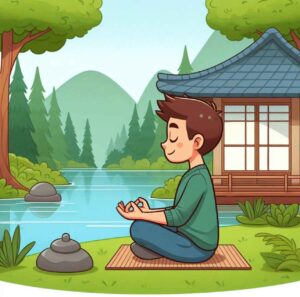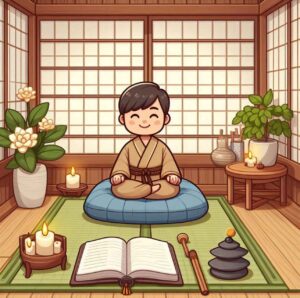Welcome Blessings!
(Tap 🔽 to see more topics!)


Our minds are like busy streets, constantly filled with honking cars, shouting vendors, and people rushing by. It’s exhausting. That’s how many of us feel every single day. We’re bombarded with information, our to-do lists are miles long, and finding a moment to breathe feels like a luxury.
You’ve probably scrolled through endless feeds, jumped from one task to another, and wondered where all your energy went. It’s not just you. Most of us are living in this whirlwind. But what if you could find a mental off-switch? Could you create a little quiet corner amidst all the noise? That’s where meditation comes in.
You’ve likely bumped into the concept of meditation somewhere along the line. Maybe someone mentioned it as a stress reliever, or you saw a fancy app promising instant calm. The whole “empty your mind” thing can sound like asking a river to stop flowing. “How on earth am I supposed to do that?” you might be thinking. “I can’t even remember where I put my keys, let alone silence my thoughts!”
The idea of sitting still and magically erasing all your worries seems unrealistic. But the thing is, meditation isn’t about becoming a superhuman mind-reader or achieving some perfect state of zen. It’s more like learning to gently guide your attention, like training a puppy to walk on a leash. It’s a practical technique proven to help people feel less stressed and more focused. Think of it as a mental tune-up, a way to hit the reset button on your brain.
In today’s article, you will learn the six simple steps to help you ease into meditation and begin experiencing a more transparent, more focused mind. Grab your comfy chair, maybe a warm drink, and let’s figure out how to find a little peace in the middle of our busy lives.

(Why Are You Meditating?)
You know how sometimes you wander around the house, not knowing what you need? Yeah, meditation can be like that if you don’t have a little direction. It’s like, you gotta know why you’re even doing it. You wouldn’t just hop in your car and start driving without knowing where you’re going, would you? Meditation is the same. Setting an intention, basically figuring out what you want to get out of it, helps you stay on course. It’s your mental map.
What kind of “destination” are we talking about? Well, it could be anything! Maybe you’ve had a crazy day at work and just chill out. You intend to let go of all that tension. Or, if you’re like me, and your brain jumps from one thing to another, you should focus on staying present. Below are some examples of what people use meditation for:
Don’t feel like you must come up with some big, life-changing goal immediately. Deciding to be present in the moment is a great place to start. Meditation isn’t about being perfect; it’s about showing up and letting yourself experience it. It’s like giving yourself permission to relax and see what happens.

(Create a Peaceful Environment)
For example, you’re trying to read an excellent book, but someone’s blasting music, the dog’s barking, and your phone’s buzzing non-stop. You’re not going to get very far, are you? That’s exactly why finding a decent spot to meditate is so important. It’s just common sense. You don’t need to go all fancy with it, like building a special room or anything. Think of it more like finding a little pocket of calm in your day. Maybe it’s:
The main thing is to minimize distractions. We’re talking about anything that’s going to pull your focus away. If noise is a big issue, below are a few tips that might help:
Honestly, we’re all busy. You might not always have time for meditation in a tranquil room. Even five minutes is better than nothing. A quick meditation break in your car can make a real difference. The point is that you’re not looking for perfection. You’re looking for peace. Find a space that works for you, even just for a few minutes.
(The Anchor of Your Mind)
Okay, you’ve found a quiet spot, maybe even lit a candle, and you’re ready to go. Now what? It is where your breath comes in, and trust me, it’s way more powerful than you might think. Remember, our mind will do what minds do – wander. It’s like trying to keep a room of toddlers quiet. They will make noise. But your breath? That’s your anchor. It’s the thing that brings you back when you start drifting off into thoughts about what you’re having for dinner or that email you forgot to send.
It’s not about doing it perfectly. But, it’s about doing it. You’re not trying to stop your thoughts. You’re just learning to notice them without getting carried away. Just keep returning to your breath, and you’ll start to feel a little calmer and more grounded. It’s that simple.
(Don’t Hold On to Them)
Now, you’re sitting there, trying to focus on your breath, and then bam! Your brain decides to remind you about that email you forgot to send, what you’re having for dinner, or that weird thing your coworker said. It’s normal. Everyone’s brain does this. Our mind is just doing its job: thinking. You’re not doing anything “wrong.”
Remember, you don’t have to wrestle those thoughts to the ground. Imagine you’re watching leaves float down a stream. You notice them but don’t jump in and try to catch every single one. That’s what meditation is like.
Sometimes, when those thoughts are sticky, do this trick: you can give them a mental label. If you’re thinking about work, say to yourself, “Work thought,” and then go back to your breath. It’s like putting a little tag on it so you can see it and let it go. It’s like training a puppy. You’re not going to yell at it for getting distracted. You’re just going to redirect it gently. The same goes for your mind. Just gently guiding it back to the present moment. It’s a practice that takes time, so be kind to yourself.
(Stay Present in the Moment)
Again, our minds are like little time machines, constantly zipping us back to that awkward thing we said yesterday or fast-forwarding to the mountain of emails waiting for us tomorrow. It’s exhausting! That’s where mindfulness comes in and is way more straightforward than it sounds.
Keep in mind that our brain loves to wander. Mindfulness is just gently nudging it back to where you are right now. It’s not about forcing yourself to feel a certain way or judging your thoughts. It’s just noticing what’s happening, like watching a movie about your experience.
Mindfulness is like using a magnifying glass on the “now.” Instead of letting your attention scatter everywhere, you focus on the little details that make up this very moment. You start noticing things you’d normally miss. The reality is your mind will wander. That’s what minds do! Please don’t beat yourself up about it. Gently bring your attention back.
It’s like training a muscle. The more you practice, the easier it gets. You’ll start to find those little moments of calm throughout your day, even when things get hectic.
(Acknowledging Your Practice)
Congratulations! You’ve just finished a meditation session. It could have been smooth sailing, or your brain felt like a bouncy castle. Either way, you did it. The cool part is, let’s finish it with gratitude. It is more like you just gave your mind a mini-vacation. Even if it was a bit of a bumpy ride, you still took the time. That’s a win. Seriously. Why gratitude? It’s like giving your brain a little pat on the back. It helps solidify the good vibes and keeps you feeling centered. How it could look:
It’s easy to get caught up in whether we did it “perfectly.” But honestly, the fact that you carved out some time matters. There is no need for fancy words, just a genuine “thank you” to yourself. When you open your eyes and return to your day, try to carry that little calm with you, heading into a meeting, tackling a mountain of emails, and chilling with a cup of coffee. Things feel less overwhelming. Finishing with gratitude is like putting a bow on your meditation. It’s a nice way to wrap things up and sets you up for a more peaceful and focused day.

Look, we’ve all had those days when our brains feel like a browser with a million tabs open. It’s exhausting and, honestly, a little overwhelming. Meditation isn’t some magic trick that instantly makes you a Zen master. Think of it more like learning to ride a bike. You might wobble at first, maybe even fall a few times, but eventually, you get the hang of it. And just like riding a bike, it gets easier and more enjoyable with practice.
Those six simple steps we talked about? They’re your training wheels. Setting your intentions, finding a quiet spot, focusing on your breath, letting thoughts drift by, staying present, and wrapping it up with gratitude – that’s your toolkit for finding a little peace in the middle of the chaos.
The best part? You can do this anywhere. Are you waiting in line at the grocery store? Do you have five minutes before a meeting? Even a few deep breaths and a quiet moment can make a difference. It’s like giving your brain a mini-spa day, a little reset button in your pocket. Next time your mind starts buzzing like a beehive, remember you’ve got the tools to find your calm. You can create a little space for yourself, even on the busiest days.
Ready to give it a try? Start small. Even just two minutes of focused breathing can be super helpful. Find a quiet corner, set a timer on your phone, and breathe. You might be surprised at how much calmer you feel. Voila! Until next time!